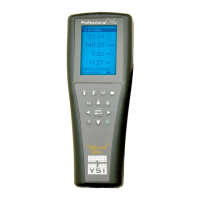TROUBLESHOOTING TIPS
1. Ensure that the correct sensor type and membrane type are enabled in the Sensor Setup Menu. Galvanic
sensors have a gray probe body and Polarographic sensors have a black probe body.
2. If using a 6051020 cable, ensure that the DO sensor is installed in port 2. If using a Quatro cable, ensure that
the DO sensor is installed in the port labeled DO.
3. Ensure the Pro Plus barometer is reading accurately. The DO % Saturation calibration uses the instrument’s
barometric pressure reading for the DO % calibration. If the barometer is not reading accurately, the
calibration will be erroneous. The barometer should be reading true barometric pressure. If you suspect the
barometer reading is incorrect, calibrate the barometer and then recalibrate the DO sensor. Laboratory
barometer readings are usually “true” (uncorrected) values of air pressure and can be used “as is” for
barometer calibration. Weather service readings are usually not “true”, i.e., they are corrected to sea level,
and therefore cannot be used until they are “uncorrected”. An approximate formula for this “uncorrection” is:
True BP in mmHg = Corrected BP in mmHg – [2.5 * (Local Altitude in ft. above sea level/100)]
4. Install a new membrane with fresh electrolyte onto the DO sensor. Ensure you are using the correct
electrolyte solution. Polarographic sensors use electrolyte that is in a white labeled bottle (KCl/Na
2
SO
4
).
Galvanic sensors use electrolyte that is in a blue labeled bottle (NaCl).
5. Recondition the DO sensor and then install a new membrane.
6. If you suspect port contamination, remove the sensor and follow the instructions in the Cleaning a Sensor
Port section.
7. If you continue to have trouble calibrating the DO sensor, contact your local YSI Representative or a YSI
Authorized Service Center.
Membrane Cap Installation
The DO membrane and electrolyte solution (O2 solution) should be changed once every 2-8 weeks depending
on use and storage. In addition, the membrane and electrolyte solution should be changed if (a) bubbles are
visible under the membrane; (b) significant deposits of dried electrolyte are visible on the membrane; or (c) if the
sensor shows unstable readings or other sensor-related symptoms. To install a new membrane cap follow these
instructions:
1. Remove the sensor guard or cal cup to access the sensor tip.
2. Unscrew and remove any old membrane cap by holding the sensor when unscrewing
the membrane cap. Discard the used membrane cap.
3. Thoroughly rinse the sensor tip with distilled or DI water.
4. Fill a new membrane cap with the appropriate electrolyte solution that has been
prepared according to the directions on the bottle. Polarographic sensors use
electrolyte that is in a white labeled bottle (KCl/Na
2
SO
4
). Galvanic sensors use
electrolyte that is in a blue labeled bottle (NaCl). Be very careful not to touch
the membrane surface during this process. Lightly tap the side of the
membrane cap to release air bubbles that may be trapped.
5. Thread the membrane cap onto the sensor. It is normal for a small amount of electrolyte
to overflow.
12

